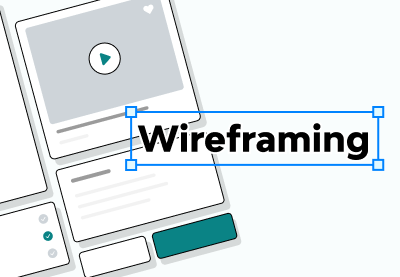Definitive Guide to Buyer Personas for Beginners
Understand the useful techniques to develop your buyer personas. This is effective in planning the marketing strategy for your audience.
In the game I Spy, the spy says “I spy with my little eye something with the color blue.” Then the players must guess what object the spy saw based on that color (or whichever color the spy chooses).

The difficulty level of this game depends on the number of items around that have the designated color. Moreover, challenging games of I Spy can be hard and sometimes tedious for spies waiting for the other player to target the correct object.
Content marketing is remarkably similar to the game “I Spy”. Your target audience understands your solutions exist, however, they are nonchalantly waiting for you to pinpoint them and deliver the message they want to hear.
Don’t want to spy with your little eye a bunch of prospects you’re missing out on? Then it’s time for you to create buyer personas.
Gaining insights into buyer personas provides valuable information about your current and potential clients. By creating personas, you will be able to tailor your marketing strategies, web copy, and other materials more efficiently. Do these for your most desired clients and you will increase your conversion rates.
Correctly defined personas will help you define who your buyers are, what environmental context they are in, and most importantly, what they are trying to achieve.
The important distinction should be made that content marketing follows buyer personas. Ready to get started… see our short guide here:
Through this tutorial, you will learn to carry out the appropriate research to create insightful buyer personas. Also, do not forget to use the free buyer persona slide deck template we provide to structure your first buyer persona.
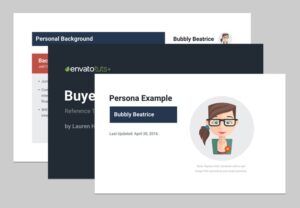
How Many Buyer Personas Should You Create?
Every persona buyer is indicative of a crucial part of your audience. The number of segments that you want to target determines the amount of personas that you will need to create.
Definitive Guide to Buyer Personas for Beginners
When building personas, marketers will most oftentimes suggest three to five. For now, focus on the one audience segment that you need the most assistance reaching out to.
How Do You Get Insights into Your Buyer Persona?
Definitive Guide to Buyer Personas for Beginners
Prior to trying to create your first buyer persona, there is some research which needs to be done.
There are many ways to create online personas and obtain more accurate data about them. Here are the internet related sources for obtaining the information needed to build a comprehensive buyer persona:
1. Set up a Feedback Poll on Your Site
Nothing competes with the human touch. Which audience would you like to reach out to? Your current clientele, prior clientele, the clients of your competitors, and also the visitors on their websites.
I recall feeling something similar during my first meeting with my clients when collecting their queries while they were ordering. Using Hotjar, I used to send feedback forms directly to the visitors of the beta version of our website on its first launch to gather information on how I could improve my offerings.
If you run an online course site, for example.
What do you expect to get out of the course? Pleasure seeking, earning a promotion, or something else? Once you have established a customer base, these questions not only allow you to set the site copy and design, but it enables you to set it appropriately and entice the clientele.
Definitive Guide to Buyer Personas for Beginners
Come up with a poll that seeks open ended answers rather than using a dropdown. I have a suggestion on how you can increase customer satisfaction: trigger the poll after five seconds. Choose one from the three suggested questions I have provided:
- Why are you looking for [insert offering] today?
- What’s missing on this page?
- Where did you first hear about us?
2. Survey Existing Customers
Again, you can use a survey to ask questions to your customers. Here’s the open-ended questions you should ask your existing customers, recommended by Hotjar:
- What led you to look for [insert offering]? Explain in as much detail as possible how it will make your life easier / better.
- What nearly stopped you from using us? List as many items as you can think of.
- What persuaded you to [insert call-to-action (CTA)]. List as many items you can think of.
- What could we have done to make your decision easier?
- How would you describe yourself? e.g. I am a 30 year old male designer that loves cars and poker.
- How would you describe us to a friend? (This is a great way to get testimonials for your site as well!)
Hotjar recommends that one should avoid lengthy surveys and their suggested requirements are eight questions maximum. With the right responses to their queries, one is able to create valuable and effective buyer personas because the answers are catered towards real customers.
3. Look for Public Reviews
For my own part, I would not advise the omission of those two methods. Nevertheless, you could develop a fairly concrete persona just by searching what the clients as well as what the clients of the competitors have to say about what you offer.
Definitive Guide to Buyer Personas for Beginners
What are places where people would post reviews for businesses such as yours? Indeed, these are little gold mines of client’s opinions. Here are some suggestions on where to start looking for reviews:
- For local businesses, visit sites like Yelp, Angie’s List, Google Local, Better Business Bureau, The Chamber of Commerce or any of these other local business review sites.
- For niche businesses, such as wedding planning offerings, check out places like theKnot and WeddingWire.
- For app developers, visit iTunes and Google Play.
- For startups, visit places like Product Hunt, GetApp, AlternativeTo and Software Advice.
- For all small businesses, check social media, especially Twitter and Facebook, and Google your business name and/or unique offering + reviews.
When you find these reviews, look for key identifying phrases that show what your customers want and expect from you. Phrases may include:
- “I wish…,”
- “When will you add…,”
- “Competitor X lets me…”
4. Evaluate Customer Engagement Throughout the Buyer’s Journey
It is important to steadily track and study the interactions of clients throughout their journeys in order to improve your buyer personas. In this step, customer analytics is important since it helps in understanding the characteristics, behavior patterns, and interactions the customers have with a brand.
Employing various methods such as Hubspot’s CRM to monitor website visits and social media activities provides an overall picture of the customer journey that results from different touchpoints. Also, modern VoIP feature rich services like Nextiva enables us to track and analyze the customer questions and emotions experienced during the conversations which gives us information on how the customer feels, what they expect, where the pain points are, and what complaints they raise.
Definitive Guide to Buyer Personas for Beginners
As a result of this everlasting practice, buyer personas and their behaviors are refreshed constantly, allowing for finer details on clients to be captured. In turn, these personas enable businesses to become more adept at marketing to the specific segments and offer personalized goods and services that appeal to desired clients.
5. Utilize Forums and Communities
Quora and Reddit type platforms may also serve as a good source of information while developing buyer personas considering you can either ask the community queries which go in handy for you or read questions that have already been discussed.
6. Listen Online
Continue to pay attention to your persona comments from the viewpoint of key insights, even after you create your buyer persona. Like other free software, Mention, Google Alerts, and Talkwalker Alerts allow you to set alert for terms which can assist you to create even more tailored content.
I find Twitter Advanced Search especially useful when looking for customer or prospect feedback. Or track hashtags that are important to your industry using tools like Hootsuite or Tweetdeck.
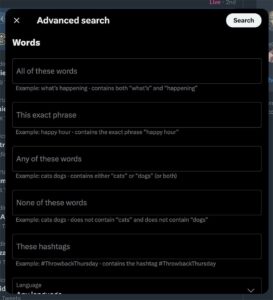
My final meritorious listen hack is to go through the comment sections of niche blog posts that have a wide readership. In case if you don’t have a list of blogs, use AllTop.
How Do You Craft Your Buyer Persona?
Merchandising goes hand in hand with market research, and all this research is what goes into creating detailed buyer personas.
Definitive Guide to Buyer Personas for Beginners
If you conduct research and buyers well, you sell more in the future because you understand what is relevant for them, what goals they want to achieve, and what you offer that can help them account for achieving their goals.
You can get our Buyer Persona Template absolutely free. And now, let’s start taking the customer research you have done and create your very first buyer persona.

In this section, we use the example of a freelance internship marketplace to craft relevant questions and demonstrate the process. Our template focuses on these eight sections:
- Demographics
- Pain Points
- Priorities
- Values
- Research Habits
- Identifying Factors
- Psychographics
And it’s segmented into these key slides:
- Persona Example
- Personal Background
- What?
- Why?
- How?
Even though this template focuses on the case study of a freelance internship marketplace, it can be used for various types of businesses. In addition to the sample in the download, there is also an easily editable section so you can customized the buyer personas that best meet your business—adding or removing sections as you feel suitable.
Now, let us examine each section in depth and discuss the questions that will enable you to form the initial draft of a buyer persona for your product.
Persona Slide
To begin with, allow us to take a look at the persona slide before moving on to the more intricate details. Collecting the data needed for your customers will assist you in creating an ideal buyer persona which is slide 3 in the template. The illustration we have below is indicative of a vibrant young professional that we plan on targeting:

Here you can customize the template and replace the character avatar placeholder with an image reflective of your target buyer persona.
Step 1: Personal Background
Demographics
Demographics let us know who our personas are. It tells us things like their age, gender, salary, location, education and family.
Ask these types of questions:
- What’s their name?
- How old are they?
- Are they male or female?
- Do they have children? If so, how many?
- Where are they located?
- Are they married or single?
- What level of education have they completed?
- Which school(s) did they attend and what was their major? Be specific.
Complete the Personal Background and the What? slides so that you can zero in on your persona’s demographic details, aspirations, and biographical information. After this, explain what your product or service intends to serve to the customer.

As a reminder, the information generated through interviewing customers and conducting research will serve as a rough heuristic for defining your target group.
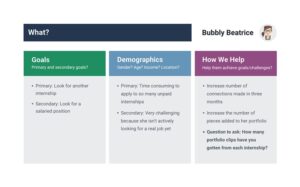
Career
In this example, we want to know about their current position, career aspirations, and goals. You may have another focal point here for your business.
Example questions:
- How did they end up where they are today?
- What industry do they work in? What type of company is it?
- What is your current job title?
- What’s your career aspiration(s)?
- How long have you been in your current position?
- Who do you report to? Who reports to you?
- How are you measured at work?
- What skills are required to do your job?
- What knowledge and software or tools do you use in your job?
Step 2: Pain Points
We want to know the buyer personas’ pain points because this will help us craft messaging that makes them feel their pain, causing them to move quickly through your purchasing cycle.
Questions:
- What frustrates you daily or often?
- Please describe in detail the the worst customer service experience you’ve ever had.
- What stresses you out?
- What makes you angry?
- What is the least favorite part of your job?
- What does the worst job you can imagine look like?
- Tell me about a purchase you made recently that you regret.
- What keeps you up at night?
- What accomplishment(s) are you most proud of? Why?
- What are the top three things on your bucket list?
Step 3: Priorities
What are your personas’ priorities? Is a tight budget their priority? Or are they motivated by what others think of them? Ordering your personas priorities allows you to craft messages that get to the point and convert quickly. For instance, if budget isn’t an issue, focus on the value of your offering.
Questions:
- What does a typical day look like for you?
- How much time do you spend at work and at home?
Step 4: Values
Consider: What do your prospects value? Do they care about the environment? Are they hungry to grow their company quickly? Clearly defined values will define how you paint the bigger picture for your audience.
Questions:
- What type of vehicles do you own and why?
- Who are the people in your life that are most important?
Pull real quotes from your customer’s answers and use them to add dimension to buyer persona in the Why? slide. And clarify what are top objections to the product or service you offer.

Step 5: Research Habits
Are your personas early adopters, or are they late to the social media party? The best way to find out how your buyer personas find and consume information is through quantitative website metrics.
Consider factors like: What are the top three sources of referral traffic to your site? What keywords have the highest search volume and drive the most traffic to your site?
Questions:
- Where do you go to learn about offerings?
- What offline resources do you use?
- What online resources do you use?
- How do you prefer to shop?
- Do you look at online reviews? Or do you ask for reviews in person?
- How important is it to get a deal?
- Which type of phone do you have?
- What do you treat yourself to often or recently?
- Which publications or blogs do you read?
- How do you learn about new information for your job?
- Which associations and social networks do you participate in?
Step 6: Identifying Factors
Why do some personas with the same demographics buy while others pull the trigger? It’s tough to say. The easiest way to answer this question may be to go straight to the sales department. What factors distinguish hot leads from okay leads? Identifying factors may be anything from questions asked during the research phase to a company’s organizational chart.
Questions:
- What do they Google when they look for your offering?
- How do they talk about your offering? What keywords do they use?
- What words or phrases make their ears perk up or get them excited?
- What words or phrases make them not excited or even upset?
Step 7: Psychographics
While demographics tell you who your persona is, psychographics tell you why they are who they are. Psychographics, or “attitudes, opinions and personality traits,” which tell you what your persona cares about. They provide a huge opportunity to craft increasingly personalized, and therefore motivating, marketing content.
Questions:
- What are their interests?
- What do you do for fun?
- What do you watch on TV?
- Would they consider themselves an introvert or extrovert?
- Would they say they’re spontaneous?
- What are their attitudes about [insert topic]?
- What are their hobbies or activities?
- Are they a risk taker or risk adverse?
- Do they tend to break or follow rules?
- Are they mostly optimistic, pessimistic or realistic?
- Are they more creative or more logical?
- How easily do they adapt to change?
- Are they more independent or more dependent?
- Do they get jealous easily?
- Do they care about what others think of them?
- How would their friends describe them?
- How would they describe themselves?
Use this information to craft your marketing message and targeted elevator pitch in the How? slide, shown below:
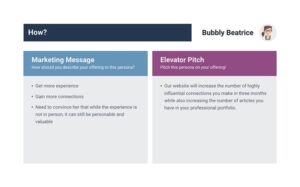
Now is the Moment to Finalize the Template
Most likely, you have done your homework, made inquiries from your clients, and have saved your potential buyer’s persona template. This means you’re ready to fill it in and make your first buyer persona.
If you don’t have the time at the moment to finish what we’ve started here, save this piece for further reading. Hope it goes well!
Editorial Note: This content was originally published in 2016. It is being published again because the editors have determined that it still contains valid information.
Definitive Guide to Buyer Personas for Beginners Understand the useful techniques to develop your buyer personas. This is effective in planning the marketing strategy for your audience. In the game I Spy, the spy says “I spy with my little eye something with the color blue.” Then the players must guess what object the spy […]
How to market to Gen Z and young professionals in 2025 How to market to Gen Z and young professionals in 2025 When considering the strategies to reach Gen Z audiences, it is essential to conduct thorough research and understand this demographic segment, so it does not become an enigma. In case you are not […]

